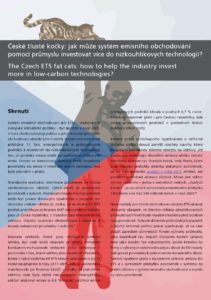Please note that this briefing produced by Sandbag and Centre for Transport and Energy (CDE) includes both Czech and English Executive summary.
The Emissions Trading System (ETS), the EU’s flagship climate policy, was introduced in 2005. Legislative reforms are currently being decided for its fourth phase (2021-2030). By putting a price on carbon for some 11,000 power and industrial installations, the ETS is intended to incentivise its participants to invest in low carbon technologies to avoid emissions costs. In practice, free emission allowances are being handed out in the EU ETS far more than originally intended.
The latest EU ETS reform process has so far rejected proposals to target free allocation primarily towards the sectors most exposed to carbon leakage in the coming decade. The list of Czech fat cats has changed since our 2011 report on Czech Fat Cats, but our investigations show that the problem of overallocation has prevailed. Among others, the cement sector – one of the biggest Czech fat cats – is on track to build up cumulative surpluses translating to a windfall profit above €20 million by 2020. Our modelling for Phase 4 of the EU ETS paints a grim picture in which most over-allocated industries are very likely to continue to be shielded from the impact of a carbon price in result of applying current EU ETS reform options for free allocation.
In context of this analysis for Phase 4, Sandbag and the Centre for Transport and Energy recommend:
- Continue support on annual cancellation from the Market Stability Reserve (MSR) and increase the MSR withdrawal rate. An even better alternative would be to remove surplus from the market quickly by rebasing the cap to the real-world level of emissions.
- Support maintaining the 57% auction share in Phase 4.
- More abatement-effective methods to protect industry from carbon leakage risk should be encouraged rather than continuing the current free allocation approach, such as Import Inclusion System (commonly referred to as a Border Tax Adjustment Mechanism).

